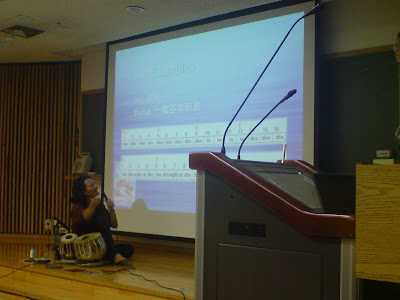
"In India, music as well as painting and the drama is considered a divine art. Brahma, Vishnu, and Shiva—the Eternal Trinity—were the first musicians. The Divine Dancer Shiva is scripturally represented as having worked out the infinite modes of rhythm in His cosmic dance of universal creation, preservation, and dissolution, while Brahma accentuated the time-beat with the clanging cymbals, and Vishnu sounded the holy mridanga or drum. Krishna, an incarnation of Vishnu, is always shown in Hindu art with a flute, on which he plays the enrapturing song that recalls to their true home the human souls wandering in maya-delusion. Saraswati, goddess of wisdom, is symbolized as performing on the vina, mother of all stringed instruments. The Sama Veda of India contains the world's earliest writings on musical science.
The foundation stone of Hindu music is the ragas or fixed melodic scales. The six basic ragas branch out into 126 derivative raginis (wives) and putras (sons). Each raga has a minimum of five notes: a leading note (vadi or king), a secondary note (samavadi or prime minister), helping notes (anuvadi, attendants), and a dissonant note (vivadi, the enemy).
Each one of the six basic ragas has a natural correspondence with a certain hour of the day, season of the year, and a presiding deity who bestows a particular potency. Thus, (1) the Hindole Raga is heard only at dawn in the spring, to evoke the mood of universal love; (2) Deepaka Raga is played during the evening in summer, to arouse compassion; (3) Megha Raga is a melody for midday in the rainy season, to summon courage; (4) Bhairava Raga is played in the mornings of August, September, October, to achieve tranquillity; (5) Sri Raga is reserved for autumn twilights, to attain pure love; (6) Malkounsa Raga is heard at midnights in winter, for valor.
The ancient rishis discovered these laws of sound alliance between nature and man. Because nature is an objectification of Aum, the Primal Sound or Vibratory Word, man can obtain control over all natural manifestations through the use of certain mantras or chants. 7 Historical documents tell of the remarkable powers possessed by Miyan Tan Sen, sixteenth century court musician for Akbar the Great. Commanded by the Emperor to sing a night raga while the sun was overhead, Tan Sen intoned a mantra which instantly caused the whole palace precincts to become enveloped in darkness.
Indian music divides the octave into 22 srutis or demi-semitones. These microtonal intervals permit fine shades of musical expression unattainable by the Western chromatic scale of 12 semitones. Each one of the seven basic notes of the octave is associated in Hindu mythology with a color, and the natural cry of a bird or beast— Do with green, and the peacock; Re with red, and the skylark; Mi with golden, and the goat; Fa with yellowish white, and the heron; Sol with black, and the nightingale; La with yellow, and the horse; Si with a combination of all colors, and the elephant.
Three scales—major, harmonic minor, melodic minor—are the only ones which Occidental music employs, but Indian music outlines 72 thatas or scales. The musician has a creative scope for endless improvisation around the fixed traditional melody or raga; he concentrates on the sentiment or definitive mood of the structural theme and then embroiders it to the limits of his own originality. The Hindu musician does not read set notes; he clothes anew at each playing the bare skeleton of the raga, often confining himself to a single melodic sequence, stressing by repetition all its subtle microtonal and rhythmic variations. Bach, among Western composers, had an understanding of the charm and power of repetitious sound slightly differentiated in a hundred complex ways.
Ancient Sanskrit literature describes 120 talas or time-measures (*Ustad Zakir Hussain has mentioned there are 365 Talas). The traditional founder of Hindu music, Bharata, is said to have isolated 32 kinds of tala in the song of a lark. The origin of tala or rhythm is rooted in human movements—the double time of walking, and the triple time of respiration in sleep, when inhalation is twice the length of exhalation. India has always recognized the human voice as the most perfect instrument of sound. Hindu music therefore largely confines itself to the voice range of three octaves. For the same reason, melody (relation of successive notes) is stressed, rather than harmony (relation of simultaneous notes).
The deeper aim of the early rishi-musicians was to blend the singer with the Cosmic Song which can be heard through awakening of man's occult spinal centers. Indian music is a subjective, spiritual, and individualistic art, aiming not at symphonic brilliance but at personal harmony with the Oversoul. The Sanskrit word for musician is bhagavathar, "he who sings the praises of God." The sankirtans or musical gatherings are an effective form of yoga or spiritual discipline, necessitating deep concentration, intense absorption in the seed thought and sound. Because man himself is an expression of the Creative Word, sound has the most potent and immediate effect on him, offering a way to remembrance of his divine origin. "
From Autobiography of a Yogi by Paramahansa Yogananda
http://www.crystalclarity.com/yogananda/













































